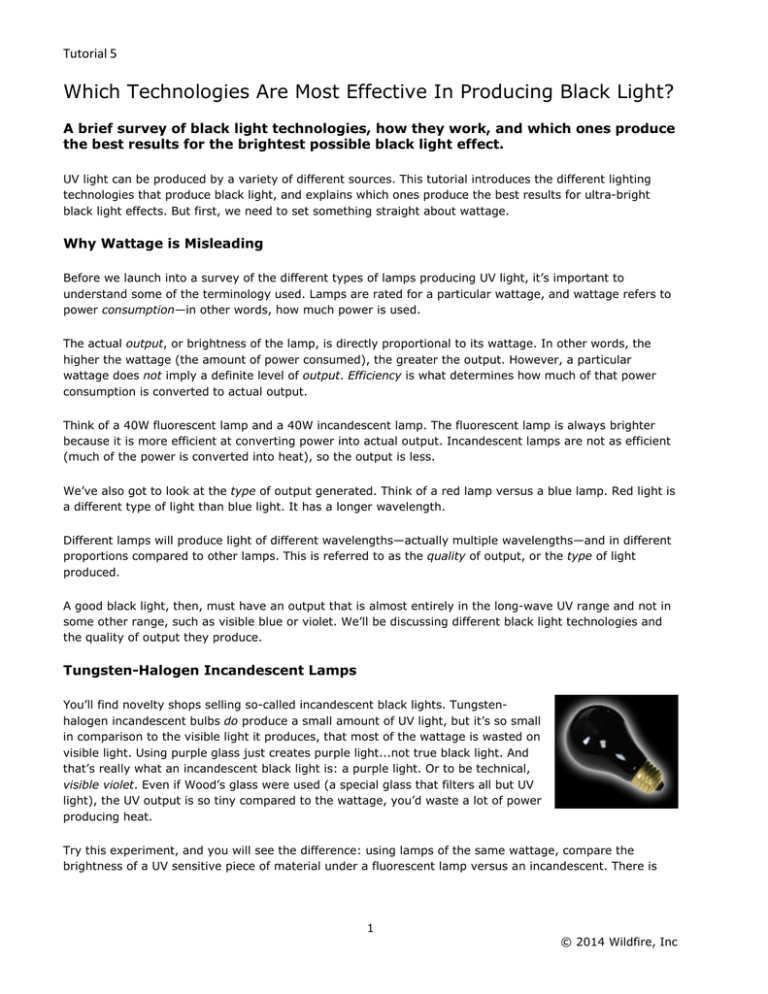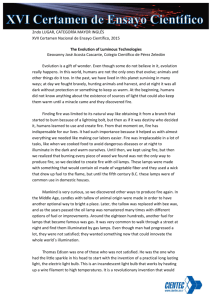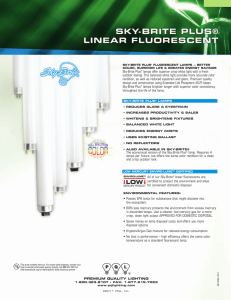Which Technologies Are Most Effective In Producing Black Light?
advertisement

Tutorial 5 Which Technologies Are Most Effective In Producing Black Light? A brief survey of black light technologies, how they work, and which ones produce the best results for the brightest possible black light effect. UV light can be produced by a variety of different sources. This tutorial introduces the different lighting technologies that produce black light, and explains which ones produce the best results for ultra-bright black light effects. But first, we need to set something straight about wattage. Why Wattage is Misleading Before we launch into a survey of the different types of lamps producing UV light, it’s important to understand some of the terminology used. Lamps are rated for a particular wattage, and wattage refers to power consumption—in other words, how much power is used. The actual output, or brightness of the lamp, is directly proportional to its wattage. In other words, the higher the wattage (the amount of power consumed), the greater the output. However, a particular wattage does not imply a definite level of output. Efficiency is what determines how much of that power consumption is converted to actual output. Think of a 40W fluorescent lamp and a 40W incandescent lamp. The fluorescent lamp is always brighter because it is more efficient at converting power into actual output. Incandescent lamps are not as efficient (much of the power is converted into heat), so the output is less. We’ve also got to look at the type of output generated. Think of a red lamp versus a blue lamp. Red light is a different type of light than blue light. It has a longer wavelength. Different lamps will produce light of different wavelengths—actually multiple wavelengths—and in different proportions compared to other lamps. This is referred to as the quality of output, or the type of light produced. A good black light, then, must have an output that is almost entirely in the long-wave UV range and not in some other range, such as visible blue or violet. We’ll be discussing different black light technologies and the quality of output they produce. Tungsten-Halogen Incandescent Lamps You’ll find novelty shops selling so-called incandescent black lights. Tungstenhalogen incandescent bulbs do produce a small amount of UV light, but it’s so small in comparison to the visible light it produces, that most of the wattage is wasted on visible light. Using purple glass just creates purple light...not true black light. And that’s really what an incandescent black light is: a purple light. Or to be technical, visible violet. Even if Wood’s glass were used (a special glass that filters all but UV light), the UV output is so tiny compared to the wattage, you’d waste a lot of power producing heat. Try this experiment, and you will see the difference: using lamps of the same wattage, compare the brightness of a UV sensitive piece of material under a fluorescent lamp versus an incandescent. There is 1 © 2014 Wildfire, Inc Tutorial 5 just no comparison. While incandescent lamps may be fine for casual hobbyists, they are worthless if you want to create a dramatic, ultra-bright UV effect. Fluorescent Lamps All fluorescent lamps operate under the same principle. Mercury vapor mixed with a rare earth gas such as argon or xenon is excited by an electrical current. The excited mercury produces short wave UV light, which then causes a powdered coating on the inside of the glass to fluoresce, giving off visible light (or black light) in return. The powdered material can be made from a variety of substances that emit different kinds of light—colored, white, full-spectrum, black light, etc. In the case of black light, or “BLB” (black light blue) as it’s called in the lighting industry, the fluorescent coating will give off long wave UV light after absorbing the short wave UV light. Black light blue lamps use a special glass called Wood’s glass, which filters out most visible light produced by the fluorescing powdery substance. A good black light fluorescent bulb will have a peak wavelength of about 365nm—right in the middle of the long-wave UV range, and perfect for producing really good black light effects as long as a good electronic ballast is used. Black light fluorescent lamps are inexpensive, easy to acquire, and are an excellent source of UV light. A good quality lamp in a properly ballasted fixture is the ideal source for many black light applications when the fixture can be mounted close the effect and a wash of black light is desired. For more information on fluorescent technology, see the product description page for our new SableLux® Fluorescent Black Light Blue Lamps, which produce up to 57% more UV output than other manufacturers’ fluorescent black lights. Light Emitting Diodes (LEDs) LED technology is advancing rapidly and has come a long way in recent years. LEDs can produce light of any wavelength. They’re energy efficient, don’t produce massive amounts of heat, and they’re long lasting. Plus, let’s face it: they’re pretty darn cool! When searching for an LED fixture, you want to be aware of both wavelength and output, while balancing that with cost. Let’s talk about wavelength… Most UV LEDs are typically available with peak wavelengths of 385-400nm. Shorter wavelengths are becoming increasingly available, but are not common. As we mentioned in the tutorial on fluorescence, 365nm is the “sweet spot” for creating ultra-bright black light effects. It’s right in the middle of the longwave UV range, and a fixture peaking at this wavelength covers the entire black light spectrum. If you’re looking for a really powerful effect—and not just the “cool factor” of having an LED fixture—look for fixtures featuring 365nm LEDs, such as our new VioStorm UV LED Lighting Series. You also need to be aware of output… 2 © 2014 Wildfire, Inc Tutorial 5 The output of a typical LED is small compared to other lighting technologies, which is why LED fixtures are made with an array of LEDs. This adds to the cost, but it may be worth it in terms of energy efficiency and durability. Unlike other technology, it takes very little wattage to produce a very bright LED. As LED technology advances and becomes more commonplace, the cost vs. output dynamic will likely continue to improve. However, at this time, there are few UV LED fixtures on the market with comparable output to even our introductory black light fluorescent fixtures, which are much less expensive. A notable exception is our VioStorm UV LED Lighting Series, which has the power and output on par with a traditional Long Throw. We believe LEDs are the future of black lighting technology, which is why we’ve developed the VioStorm UV LED series. It was designed to be the best of its class in every respect, and it really delivers. Mercury-Xenon Arc Lamps Xenon arc lamps can be made to produce massive amounts of light—up to 15 kilowatts. These lamps are vacuum-sealed quartz enclosures filled with xenon gas. Electric current “arcs” across a gap between two terminals and creates a small ball of plasma. Pure xenon arc lamps produce light across the entire spectrum—including UV light—and closely mimic sunlight. However for UV applications, adding mercury vapor to the mix will produce massive amounts of UV light across the entire UV range. Because of this, they are often used for curing, sterilization, and ozone creation. For entertainment applications, you’d obviously need to filter out the medium-wave and short-wave UV as well as visible light. Mercury-xenon technology is also extremely expensive compared to fluorescent or metal-halide. These lamps will outshine even the brightest metal-halide lamps. However, we’ve yet to see an entertainment application requiring this much output. It’s overkill and it’s expensive. Deuterium Arc Lamps This technology is similar to xenon arc lamps in that gas is under pressure inside a vacuum-sealed enclosure with a gap between two electric terminals. An electric current arcs across the gap and excites the deuterium, producing a continuous spectrum of UV light. (Deuterium is a stable isotope of hydrogen, containing an extra neutron in its nucleus.) This technology might be ideal for entertainment applications except for its higher cost. It is currently used in scientific applications such as spectroscopy, where a continuous spectrum of UV light is desired. Metal Halide Arc Lamps Metal halide lamps contain a high-pressure mixture of argon, mercury, and various metal halides. (A halide is an ionized form of a halogen, which is the general name for a group of elements: fluorine, chlorine, bromine, iodine, and astatine.) 3 © 2014 Wildfire, Inc Tutorial 5 An electric current excites and ionizes the argon gas, which helps the electric current arc across a gap between two terminals. The heat generated by the arc then vaporizes the mercury and metal halides, which produce light as the temperature and pressure increases. The mixture of halides will affect the nature of the light produced and its intensity. In our patented IronArc® Metal-Halide Lamps, we’ve used iron iodide to boost the UV output by an average of 35% over conventional metal halides. This is one of the key secrets behind the legendary Wildfire Effect and it’s one of the ways you can get the brightest possible black light effect for your application. To sum up, fluorescent, metal-halide and now 365nm UV LED technology remain the best solutions for the widest range of black light applications. Wildfire constantly works to find innovative ways of getting the most UV output using these technologies. 4 © 2014 Wildfire, Inc


